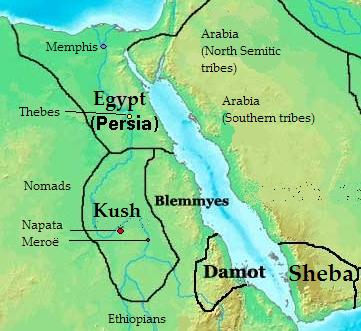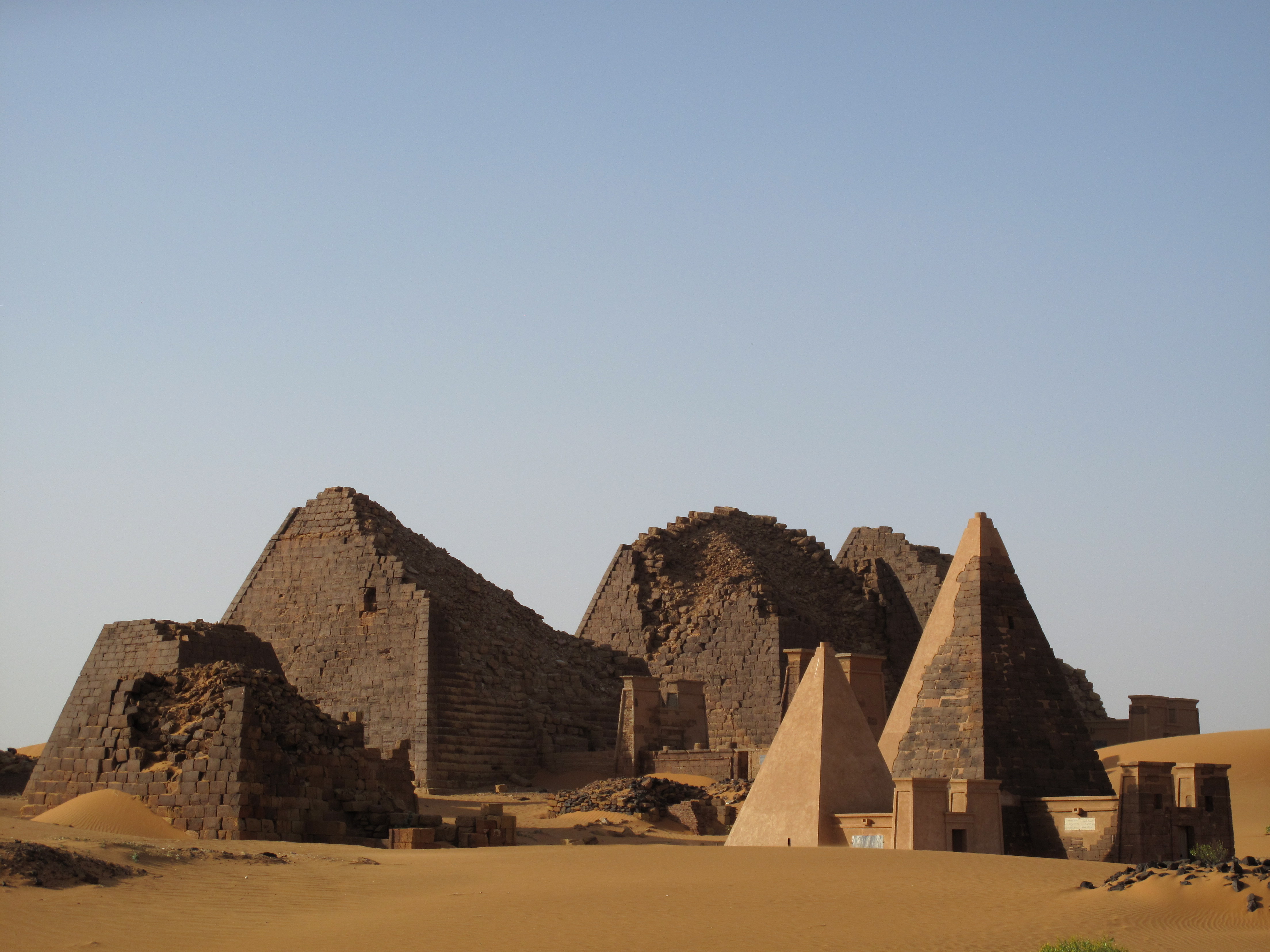 Connecting Massachusetts Standard: Grade 6
Connecting Massachusetts Standard: Grade 6
Describe evidence used by archaeologists and historians to draw conclusions about ancient Nubia.
Focus Question:
What have archaeologists found about the society and economy of Ancient Egypt and Ancient Nubia?
Topics on the Page
|
1. The Kingdom of Kush
|
5. Trade and Commerce |
|
2. The Pyramids of Meroe
|
6. Women's History Resources |
|
3. Arts and Poetry
|
7. Learning Resources |
|
4. Religious Practices
|
8. Additional Sources |
1. The Kingdom of Kush

-
“African people from what is now the Sahara began to move toward the Nile in Nubia by around 5000 BC. They brought with them the art of making pottery. Originally herdsmen and hunters of large animals, they eventually became fishermen and farmers. Over time, new people moved into the region from the south, so that Nubia’s population was often a diverse mix of African peoples” (U. of Chicago).
-
The Kingdom of Kush was the “the kingdom that dominated the region between roughly 2500 B.C. and A.D. 300” (Kushkush). Despite the Eurocentric notion that the native “negroid” race in the region only developed as a result of Egyptian immigrants and imported Egyptian civilization, excavation and archeology suggests otherwise. Before roughly 1500 B.C. and after the eleventh century B.C., “the kingdom rivaled and at times overtook Egypt” (Kushkush).
first cataract of the Nile in the north and the fourth cataract in the south” (Kushkush).

- “This first Kushite kingdom traded in ivory, gold, bronze, ebony and slaves with neighboring states such as Egypt and ancient Punt, along the Red Sea to the east, and it became famous for its blue glazed pottery and finely polished, tulip-shaped red-brown ceramics” (Kushkush).
-
“Around 1500 B.C., Egypt's pharaohs marched south along the Nile and, after conquering Kerma, established forts and temples, bringing Egyptian culture and religion in to Nubia” (Kushkush).
-
“Piye, Napata’s third king, known more commonly in Sudan as Piankhi, marched north” (Kushkush). Piye and his coalition defeated Egyptian princes and “established Egypt’s 25th Dynasty, whose kings are commonly known as the Black Pharaohs” (Kushkush). Upon his return to Napata, he continued
to revive the Egyptian tradition of entombing kings in pyramids” (Kushkush).
FUN FACT: “One of Piye’s sons, Taharqa, known in Sudan as Tirhaka, was mentioned in the Hebrew Bible as an ally of Jerusalem’s King Hezekiah” (Kushkush).
-
“By the fourth century A.D., the power of Kush began to wane. Historians give different explanations for this, including climate change-driven drought and famine and the rise of a rival civilization in the east, Aksum, in modern-day Ethiopia” (Kushkush).

SIGNIFICANCE AND LEGACIES OF THE KINGDOM OF KUSH
 READ: In the land of Kush (Smithsonian Magazine)
READ: In the land of Kush (Smithsonian Magazine)
 READ: The History of Ancient Nubia (University of Chicago)
READ: The History of Ancient Nubia (University of Chicago)
 EXPLORE: Nubia: Struggling to Protect a Glorious Past (PBS)
EXPLORE: Nubia: Struggling to Protect a Glorious Past (PBS)
2. The Pyramids of Meroe
- The Pyramids of Meroe were named a Unesco World Heritage site in 2011 (Kushkush).

-
The Pyramids of Meroe, “primarily dating from 300 B.C. to A.D. 350, mark the tombs of royalty of the Kingdom of Kush, which ruled Nubia for centuries” (Burgess)
-
“The Nubian pyramids differ from Egyptian ones: They are smaller—20 to 90 feet on a side, compared with the Great Pyramid’s 756 feet—with much steeper sides, and most were built two thousand years after those at Giza” (Burgess).
 VIEW: The Pyramids of Meroe (Google Maps)
VIEW: The Pyramids of Meroe (Google Maps)
 READ: A New Look at the Little-Known Pyramids of Ancient Nubia (Atlas Obscura)
READ: A New Look at the Little-Known Pyramids of Ancient Nubia (Atlas Obscura)
 READ: Archeological Sites of the Island of Meroe (UNESCO)
READ: Archeological Sites of the Island of Meroe (UNESCO)
3. Arts and Pottery

-
Archaeologists have found similar styles of pottery and artwork inside the tombs of both Egyptian and Nubian pharaohs.
-
Sketches carved into the tombs tell archaeologists that the Nubians and Egyptians borrowed ideas from each other. For example, the “White Crown” that both rulers wore.
-
Pottery was found to be similar as well. Artwork depicting the same mythological deities as the Egyptians worshiped has also recovered.
-
In the process of making pottery, “The potter might coat a surface with ochre, or paint, incise, or puncture designs, then carefully burnish the pot by smoothing it with a pebble before it was fired. When set mouth downward in the firing pit, the rim and interior of the pot was darkened” (U. of Chicago)
-
Much of the evidence of ancient Egyptian and Nubian history comes from the writings of Nubian Kings in 750 B.C., written in Egyptian.
-
The language of the Nubians is not fully understood, as they used Egyptian hieroglyphics for the majority of their history. Their Meroitic language is still being deciphered.
-
Archaeologists that are continuing to piece together the ancient world decipher words and phrases of Ancient Meroitic writings because of their shared similarities between modern languages and the local dialects of people from Darfur and Eritrea.
 READ: Gold and the Gods: Jewels of Ancient Nubia to go on view at the Museum of Fine Arts, Boston
READ: Gold and the Gods: Jewels of Ancient Nubia to go on view at the Museum of Fine Arts, Boston
 READ: Ancient Nubia: A-Group Pottery (University of Chicago)
READ: Ancient Nubia: A-Group Pottery (University of Chicago)
 READ: Ancient Nubia: Art of the 25th Dynasty from the Collection of the Museum of Fine Arts, Boston
READ: Ancient Nubia: Art of the 25th Dynasty from the Collection of the Museum of Fine Arts, Boston
4. Religious Practices 
-
“Despite their close proximity to Ancient Egypt, a civilization that practiced what many historians consider one of the most extensive religious systems in the ancient world, Kushites possessed an intricate pantheon in their own right” (Wikipedia). However, due to a lack of Nubian texts and artifacts, much of early Nubian religion remains unclear.
-
The ancient Nubians were influenced by ancient Egyptian mythology after the fall of the 25th Dynasty in Egypt. Some commonalities include the presence of pharaohs, the building of pyramids, and the belief in an afterlife.
-
Some of the Nubian deities included Apedemak, the lion-protector god, his consort, Amesemi, Aman, a ram-headed god, etc.
-
The Egyptian goddess, Isis, “was absorbed [by the Meroitic Kushites] and became a representation of traditional Nubian goddesses” (Wikipedia).
 READ: Kushite Religion (Wikipedia)
READ: Kushite Religion (Wikipedia)
5. Trade and Commerce 
-
“The Kush Kingdom's location on the Nile River made it a major trade hub between Sub-Saharan Africa and Egypt. Ivory, ebony, and exotic animals funneled from Kerma to Egypt, but gold became the Kush's most valued export. The Kush Kingdom was known to Egyptians as the land of gold; Egyptians had an insatiable appetite for gold jewelry, funerary marks, and gold-leaf coffins. Providing this gold became the Kush's primary source of wealth and power” (PBS).
-
“The copper tools (the earliest metal tools so far discovered in Sudan) and the pottery of Egyptian origin unearthed from A-Group graves show the flowering of the culture to have been contemporary with the first dynasty in Egypt” (Libertarianism.org).
-
“The A Group benefited from the gold deposit and carnelian from the Nubian desert. They traded with the Egyptians and sailed in large vessels to kingdoms along the Red Sea and Mediterranean coasts in ebony, olive oil, ivory, and incense—the dominant commodities in the ancient world” (Libertarianism.org).
-
Both Egyptian and Kushite civilizations shared trade routes on the Nile River.
-
The commerce in Kushite metropolises of Kerma, Napata and Meroe were similar yet individual.
-
“According to recent archaeological excavations in Sudan, there are strong reasons to peg the economy of Kerma [a city in ancient Nubia] around crop cultivation, pastoralism and gold processing. Pastoralism was the bedrock of Kerma life, and like other Nubian cultures that followed, livestock, bovines, and caprines were important to social life” (Libertarianism.org).
-
Some common crops of this region included wheat, barley, millet, lentils, and peas and cattle were raised for their hides, milk, and meat.
-
Pottery, jewelry and rare animals also constituted great wealth and luxury in the ancient world and gold and precious stones formed a great amount of Kerma’s external trade.
-
In Napata, life was “centered around agriculture and animal husbandry, although its economy was based on the trade in gold with Egypt” (Libertarianism.org).
-
“The number of cattle an individual owned determined his wealth and there is no evidence of royal restrictions that barred the trade of cattle for other commodities” (Libertarianism.org).
-
When “The Kushites moved to Meroe. The new metropolis played a significant role in trade along the Nile River having evolved out of the preceding Napatan culture” (Libertarianism.org).
-
Meroe served as a trade city to merchants from Persian Egypt, like Kerma.
-
“Its economy was based on agriculture and an iron production—Meroe’s iron products were among the best in the history of the ancient world. They leveraged this comparative advantage as far as Rome, which capitalized on the trade in exotic animals like leopard and elephants, which were important to warfare during this period” (Libertarianism.org).
 READ: Commerce and Trade in Ancient Africa: Kush (Libertarianism.org)
READ: Commerce and Trade in Ancient Africa: Kush (Libertarianism.org)
 WATCH: Kush’s Rise to Power | Rise of the Black Pharaohs
WATCH: Kush’s Rise to Power | Rise of the Black Pharaohs
 6. Women's History Resources
6. Women's History Resources
People are most familiar with the Egyptian Queen Cleopatra, similar to the Egyptians,
Nubian women played an important and often times powerful role in society.

.png) READ: Women in Ancient Egypt (World History Encyclopedia)
READ: Women in Ancient Egypt (World History Encyclopedia)
.png) READ: Role of Women in Nubia (University of Pennsylvania)
READ: Role of Women in Nubia (University of Pennsylvania)
.png) READ (FOR KIDS): Egyptian Women (History for Kids)
READ (FOR KIDS): Egyptian Women (History for Kids)
.png) READ: Remembering the Remarkable Queens Who Ruled Ancient Nubia (Atlas Obscura)
READ: Remembering the Remarkable Queens Who Ruled Ancient Nubia (Atlas Obscura)
.png) READ: Women in Ancient Kush (Oxford Academic)
READ: Women in Ancient Kush (Oxford Academic)
 WATCH: Women of Nubia: Early Representatives of the Goddess (Saint Louis Art Museum)
WATCH: Women of Nubia: Early Representatives of the Goddess (Saint Louis Art Museum)
7. Learning Resources
 EXPLORE: Internet Ancient History Sourcebook: Egypt
EXPLORE: Internet Ancient History Sourcebook: Egypt
 EXPLORE: Nubia Resources (Pardee School of Global Studies)
EXPLORE: Nubia Resources (Pardee School of Global Studies)
.png) READ (FOR KIDS): Ancient Kingdom of Kush (Nubia)
READ (FOR KIDS): Ancient Kingdom of Kush (Nubia)
.png) READ: Nubia | World Civilization
READ: Nubia | World Civilization
.png) READ: The Land of Nubia (The Met)
READ: The Land of Nubia (The Met)
 WATCH: Understanding Ancient Nubia from Antiquity to Today (Getty Museum)
WATCH: Understanding Ancient Nubia from Antiquity to Today (Getty Museum)
8. Additional Sources
 EXPLORE: History: Egyptians (BBC)
EXPLORE: History: Egyptians (BBC)
.png) READ: Research on Egyptian and Nubian settlement archeology (Open Access Government)
READ: Research on Egyptian and Nubian settlement archeology (Open Access Government)
.png) READ: The Nubian Pastoral Culture as Link between Egypt and Africa (academia.edu)
READ: The Nubian Pastoral Culture as Link between Egypt and Africa (academia.edu)
.png) READ: Ancient Nubia: A Brief History (Live Science)
READ: Ancient Nubia: A Brief History (Live Science)
.png) READ: In Sudan, Rediscovering Ancient Nubia Before It’s Too Late (Undark.org)
READ: In Sudan, Rediscovering Ancient Nubia Before It’s Too Late (Undark.org)
.png) READ: Burial sites show how Nubians, Egyptians integrated communities thousands of years ago in Nile River Valley area (Phys.org)
READ: Burial sites show how Nubians, Egyptians integrated communities thousands of years ago in Nile River Valley area (Phys.org)
Multimedia Sources
 WATCH: Ancient Nubia, Egypt’s Rival in Africa (Penn Museum)
WATCH: Ancient Nubia, Egypt’s Rival in Africa (Penn Museum)
 WATCH: Egypt vs. Nubia: A History of Ancient Rivalry (HomeTeam History)
WATCH: Egypt vs. Nubia: A History of Ancient Rivalry (HomeTeam History)
Additional Background
“The Black Pharaohs’ rule of Egypt lasted for nearly a century, but Taharqa lost control of Egypt to invading Assyrians. Beginning in the sixth century B.C., when Napata was repeatedly threatened by attack from Egyptians, Persians and Romans, the kings of Kush gradually moved their capital south to Meroe. The city, at the junction of several important trade routes in a region rich in iron and other precious metals, became a bridge between Africa and the Mediterranean, and it grew prosperous” (Kushkush).
-
Three significant kandak
 es include Amanirenas, Amanitore and Amantitere
es include Amanirenas, Amanitore and Amantitere
-
Amanirenas, “a warrior-queen who ruled Kush from roughly 40 B.C. to 10 B.C… led an army to fight off the Romans to the north and returned with a bronze statue head of Emperor Augustus, which she then buried in Meroe beneath the steps to a temple dedicated to victory” (Kushkush).
-
Amanitore, “who ruled from about 1 B.C. to A.D. 25, is portrayed beside her co-regent, King Natakamani, on the entrance-gate wall of a temple dedicated to the indigenous lion god Apedemak; they are depicted slaying their enemies—Amanitore with a long sword, Natakamani with a battle-ax—while lions rest symbolically at their feet” (Kushkush).
-
Amantitere “is the Kushite queen referred to as ‘Candace, queen of the Ethiopians’ in the New Testament, whose treasurer converted to Christianity and traveled to Jerusalem to worship” (Kushkush).
Comments (0)
You don't have permission to comment on this page.